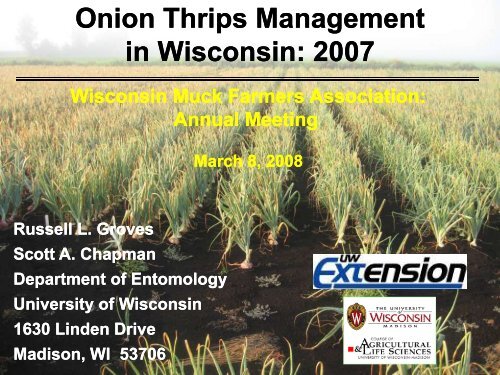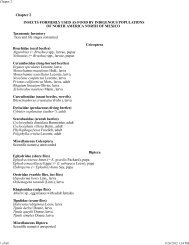Onion thrips management in Wisconsin
Onion thrips management in Wisconsin
Onion thrips management in Wisconsin
Create successful ePaper yourself
Turn your PDF publications into a flip-book with our unique Google optimized e-Paper software.
<strong>Onion</strong> Thrips Management<br />
<strong>in</strong> Wiscons<strong>in</strong>: 2007<br />
Wiscons<strong>in</strong> Muck Farmers Association:<br />
Annual Meet<strong>in</strong>g<br />
March 8, 2008<br />
Russell L. Groves<br />
Scott A. Chapman<br />
Department of Entomology<br />
University of Wiscons<strong>in</strong><br />
1630 L<strong>in</strong>den Drive<br />
Madison, WI 53706
Target Pests <strong>in</strong> 2007: Seed Maggot<br />
<strong>Onion</strong> Maggot<br />
Delia antiqua<br />
Seed corn Maggot<br />
Delia platura<br />
Maggot Damage
Seed maggot: Management<br />
Cultural<br />
‣Speed up germ<strong>in</strong>ation:<br />
Early season row cover<br />
pre-sprout, mulch, warm soil<br />
‣Avoid green manure<br />
‣Fly-free periods<br />
Biological<br />
‣Predacious soil beetles<br />
‣Fungal epidemics<br />
Entomophthoraceae<br />
Chemical<br />
‣In-furrow, <strong>in</strong>secticides (Lorsban)<br />
‣Commercial seed treatments (Poncho)
Next major onion pest:<br />
<strong>Onion</strong> <strong>thrips</strong><br />
larva<br />
<strong>Onion</strong> Thrips Damage<br />
adult<br />
<strong>Onion</strong> Thrips,<br />
Thrips tabaci L<strong>in</strong>deman<br />
‘silver<strong>in</strong>g’
<strong>Onion</strong> <strong>thrips</strong> development and damage<br />
egg<br />
pre-pupapupa<br />
adult<br />
1 st<br />
larvae<br />
2 nd<br />
pupa<br />
Development Stages<br />
• Rasp<strong>in</strong>g mouthparts puncture plant surfaces.<br />
• Egg-lay<strong>in</strong>g also damages plants.<br />
• Injury appears <strong>in</strong> streaks rather than spots ‘silver<strong>in</strong>g’.<br />
• Virus vectors (TSWV, INSV, IYSV)<br />
Thrips Damage
<strong>Onion</strong> <strong>thrips</strong>: Management<br />
Cultural<br />
Lepto<strong>thrips</strong><br />
‣ Crop rotation<br />
‣ Overhead irrigation<br />
‣ Sanitation (culls & field borders)<br />
Biological<br />
‣ Predacious <strong>thrips</strong><br />
‣ M<strong>in</strong>ute pirate bugs<br />
Chemical<br />
‣ Foliar sprays<br />
‣ Commercial seed treatments<br />
M<strong>in</strong>ute pirate bug
Research Outl<strong>in</strong>e: 2007<br />
I. Investigate the potential of <strong>in</strong>secticide seed treatments<br />
to reduce onion <strong>thrips</strong> and onion maggot <strong>in</strong>festations.<br />
II. Evaluate select cultural control practices to delay onion<br />
<strong>thrips</strong> <strong>in</strong>festations us<strong>in</strong>g wheat straw mulches.<br />
III. Document and evaluate candidate <strong>in</strong>secticides for the control of onion<br />
<strong>thrips</strong> and <strong>in</strong>vestigate the potential for reduced-risk risk compounds to expand<br />
current labels.<br />
IV. Ref<strong>in</strong>e the use patterns of current registrations to improve long-term<br />
control of onion <strong>thrips</strong> populations.
I. Insecticide Seed Treatments:<br />
Early Season <strong>Onion</strong> Thrips Control<br />
Treatments<br />
‣ Trigard<br />
‣ Lorsban 15G<br />
‣ Entrust<br />
‣ Poncho 600<br />
‣ Mundial 500<br />
Seed Dynamics<br />
Incotec<br />
Nondestructively sampled<br />
3, weekly sample dates:<br />
‣ 15, 22, & 29 June
I. 2007 Insecticide Seed Treatment<br />
Evaluations 1,2<br />
Product Active Ingredient Rate (amnt/unit)<br />
Trigard cyromaz<strong>in</strong>e 5.0 g [a.i.] / 100 g<br />
Lorsban 15G chlorpyrifos 476 g [a.i.] / 1,000<br />
Entrust sp<strong>in</strong>osad 0.3 mg [a.i.] / seed<br />
Mundial 500 fipronil 2.5 g [a.i.] / 100<br />
Poncho 600 clothianad<strong>in</strong> 0.2 mg [a.i.] / seed<br />
UTC -- --<br />
Note: Products highlighted <strong>in</strong> yellow were labeled on onion <strong>in</strong> WI <strong>in</strong> 2007<br />
1<br />
Experiment arranged as RCBD with 5 replicates.<br />
2<br />
Experimental seed treatments supplied by Seed Dynamics (Sal<strong>in</strong>as, CA) and<br />
Incotec (Sal<strong>in</strong>as, CA).<br />
Note: All have been or are currently <strong>in</strong> review with IR-4 as seed treatments.
Mean larvae / plant<br />
I. <strong>Onion</strong> Thrips ‘Suppression’ Us<strong>in</strong>g<br />
Insecticide Seed Treatments<br />
12<br />
UTC<br />
Lorsban 15G<br />
Entrust<br />
9<br />
Trigard<br />
Poncho 600<br />
Mundial 500<br />
Action threshold = 5 larvae / plant<br />
6<br />
3<br />
0<br />
7 June 22 June<br />
6 July
Mean adult <strong>thrips</strong> / trap<br />
I. Early Season, <strong>Onion</strong> Thrips Ecology<br />
2500<br />
‣ Colonize onion <strong>in</strong> late June to July<br />
‣ Four to six generations per season<br />
2000<br />
1500<br />
1000<br />
500<br />
Thrips Suppression<br />
Interval<br />
0<br />
145 159 176 189 206 220 237 251 268<br />
May<br />
June<br />
July<br />
August<br />
Sept<br />
Date
I. <strong>Onion</strong> Thrips Suppression Summary:<br />
Seed Treatments<br />
‣ Immature onion <strong>thrips</strong> populations did not exceed<br />
established thresholds<br />
‣ Trigard and Lorsban 15G failed to provide <strong>thrips</strong><br />
suppression compared with UTC<br />
‣ Thrips suppression extended over 2 out of 3<br />
successive weeks (Entrust, Mundial).<br />
‣ Suppression level was <strong>in</strong>sufficient to ma<strong>in</strong>ta<strong>in</strong><br />
populations below damag<strong>in</strong>g levels
II. Cultural Practices to Slow / Lower<br />
Early Season Thrips Colonization<br />
A.) Straw Mulches:<br />
Erosion Control Blanket (Straw and Coconut raw<br />
material)<br />
adult <strong>thrips</strong><br />
Yellow sticky cards
Mean adult <strong>thrips</strong> / trap<br />
I. Early Season: Thrips Colonization<br />
A.) Measur<strong>in</strong>g Colonization (<strong>thrips</strong> colonization):<br />
350<br />
300<br />
250<br />
200<br />
Thrips Suppression<br />
Interval<br />
F=3.92, df = 7, 15, P=0.0763<br />
150<br />
100<br />
50<br />
0<br />
138 145 152 159 166 176 183 189<br />
May<br />
June<br />
July<br />
Date
Mean adult <strong>thrips</strong> / trap<br />
I. Cultural Practices to Slow / Lower<br />
Early Season Thrips Colonization<br />
A.) Measur<strong>in</strong>g Colonization (<strong>thrips</strong> colonization):<br />
5000<br />
4500<br />
4000<br />
3500<br />
3000<br />
2500<br />
2000<br />
1500<br />
1000<br />
500<br />
0<br />
138<br />
145<br />
May<br />
Thrips Suppression<br />
Interval<br />
152<br />
159<br />
166<br />
176<br />
June<br />
183<br />
189<br />
196<br />
July<br />
206<br />
213<br />
220<br />
227<br />
August<br />
237<br />
244<br />
251<br />
259<br />
Sept<br />
268<br />
Date
II. Foliar-Applied Insecticides<br />
2007 Product Evaluations<br />
Product Active Ingredient Rate (amnt/acre)<br />
Warrior lambda-cyhalothr<strong>in</strong> 1.9 and 3.8 fl oz<br />
Mana - Silencer lambda-cyhalothr<strong>in</strong> 1.9 and 3.8 fl oz<br />
Lannate LV methomyl 48 fl oz<br />
Sp<strong>in</strong>Tor 2SC sp<strong>in</strong>osad 4 and 6 fl oz<br />
*Radiant SC sp<strong>in</strong>etoram 5 and 7 fl oz<br />
**Carzol SP formetanate hydrocloride 0.75, 1 and 1.5 lbs<br />
Movento spirotetramat 5 and 8 fl oz<br />
Agri-Mek 0.15EC abamect<strong>in</strong> 8 and 10 fl oz<br />
Note: Products highlighted <strong>in</strong> yellow were labeled on onion <strong>in</strong> WI <strong>in</strong><br />
2007;<br />
*Radiant received a Section 3c label use <strong>in</strong> November, 2007.<br />
**Carzol was permitted for use <strong>in</strong> WI under a Section 18, 2007.
II. Reduced Risk Foliar Options<br />
New Registration 2007<br />
Radiant ® SC (sp<strong>in</strong>etoram)<br />
Macrocyclic lactone (sp<strong>in</strong>osad: MoA group 5)<br />
- Use rate 4.5 - 6 oz a.i./a (CPB)<br />
- Control of onion <strong>thrips</strong><br />
10-14 14 days persistence (photostability)<br />
Very low impact on beneficials<br />
Low mammalian toxicity
II. Reduced Risk Foliar Options<br />
New Registrations 2009<br />
Movento ® (spirotetramat):<br />
‣ Tetramic acid class (MoA Group 23)<br />
• Use rate 5 – 7 fl oz (Thysanoptera)<br />
• Fully systemic movement (2 directions)<br />
‣ 10 - 14 days persistence<br />
‣ Very low impact on beneficials<br />
‣ Very low mammalian toxicity<br />
‣ IR-4, Review
II. Reduced Risk Foliar Options<br />
New Registrations 2009-10<br />
Agri-Mek<br />
® 0.15 EC (abamect<strong>in</strong>):<br />
‣ Chlor<strong>in</strong>e channel activators (MoA Group 6)<br />
• Use rate 8 – 16 fl oz (Thysanoptera)<br />
‣ 7-10 days persistence<br />
‣ Very low impact on beneficials<br />
‣ Very low mammalian toxicity<br />
‣ IR-4 In-Review: ‘On-Hold’ (2009-2010) 2010)
Mean number of larvae/plant<br />
II. Foliar-Applied Insecticides for <strong>Onion</strong> Thrips<br />
Control: 3 dat<br />
16<br />
14<br />
12<br />
10<br />
c<br />
WI Registration<br />
Section 18<br />
Non-registered<br />
Note: Plot sprayed on 7/18 @ 3 dat<br />
threshold of 1 <strong>thrips</strong>/leaf.<br />
P=0.0245<br />
8<br />
6<br />
4<br />
2<br />
0<br />
UTC<br />
Warrior 1.92<br />
Action threshold = 7.0 <strong>thrips</strong> / plant<br />
bc<br />
bc<br />
bc<br />
c<br />
c<br />
c<br />
bc<br />
Warrior 3.84<br />
Silencer 1.92<br />
Silencer 3.84<br />
Lannate<br />
Sp<strong>in</strong>Tor 6.0<br />
Sp<strong>in</strong>Tor 8.0<br />
Radiant 5.0<br />
c<br />
c<br />
bc<br />
b<br />
Radiant 7.0<br />
Carzol (0.5)<br />
Carzol (0.75)<br />
Carzol (1.0)<br />
Movento (8.0)<br />
Movento (12.0)<br />
c<br />
bc<br />
bc<br />
c<br />
Agi-Mek 8.0<br />
Agri-Mek 10.0)<br />
c<br />
Treatment
Mean number of larvae/plant<br />
II. Foliar-Applied Insecticides for <strong>Onion</strong> Thrips<br />
Control: 14 dat<br />
60<br />
50<br />
40<br />
a<br />
WI Registration<br />
Section 18<br />
Non-registered<br />
Note: Plot sprayed on 7/18 and 7/24.<br />
P
Examples of Suggested Sequences<br />
(Note: IF Carzol receives Section 18)<br />
1a. Early matur<strong>in</strong>g onion varieties<br />
Product Threshold # Sprays<br />
Carzol SP 1-3 <strong>thrips</strong>/leaf 2<br />
Radiant SC 3 <strong>thrips</strong>/leaf 1-2<br />
Lannate LV 1 <strong>thrips</strong>/leaf 0-2
Examples of Suggested Sequences<br />
(Note: IF Carzol receives Section 18)<br />
1b. Early matur<strong>in</strong>g onion varieties<br />
Estimated<br />
Product Threshold # Sprays<br />
Sp<strong>in</strong>Tor 2SC 1 <strong>thrips</strong>/leaf 2<br />
Carzol SP 1-3 <strong>thrips</strong>/leaf 1-2<br />
Lannate LV 1 <strong>thrips</strong>/leaf 0-2
Examples of Suggested Sequences<br />
(Note: IF Carzol receives Section 18)<br />
2a. Late-matur<strong>in</strong>g varieties<br />
Product Threshold # Sprays<br />
Carzol SP 1-3 <strong>thrips</strong>/leaf 2<br />
Radiant SC 3 <strong>thrips</strong>/leaf 2<br />
Lannate LV 1 <strong>thrips</strong>/leaf 0-2<br />
OP/pyrethroid 1 <strong>thrips</strong>/leaf 0-2
Examples of Suggested Sequences<br />
(Note: IF Carzol receives Section 18)<br />
2b. Late-matur<strong>in</strong>g varieties<br />
Estimated<br />
Product Threshold # Sprays<br />
Sp<strong>in</strong>Tor 2SC 1 <strong>thrips</strong>/leaf 2<br />
Carzol SP 1-3 <strong>thrips</strong>/leaf 2<br />
Lannate LV 1 <strong>thrips</strong>/leaf 2<br />
OP/pyrethroid 1 <strong>thrips</strong>/leaf 0-2
Insecticide Control Failures <strong>in</strong> Wiscons<strong>in</strong><br />
are more Frequent Because…<br />
‣ Populations <strong>in</strong> Wiscons<strong>in</strong> may be resistant, similar to<br />
populations <strong>in</strong> other locales.<br />
Environmental conditions become hot and dry.<br />
Spray coverage may be <strong>in</strong>adequate.<br />
Application threshold adjustments.
IV. Increas<strong>in</strong>g Spray Coverage<br />
‣ Randomized Complete Block: (Warrior EC, Carzol SP)<br />
‣ Application Volumes:<br />
30, 60, & 90 gpa<br />
‣ Nozzle Types:<br />
XR Teejet® Extended Range Flat Fan Tips (FF)<br />
Tw<strong>in</strong>Jet® Even Flat Spray Tips (DFF)<br />
Turbo Teejet® Wide Angle Flat Spray Tips (TU)<br />
Conejet® Visi-flo® Hollow Cone Spray Tips (HC)<br />
HC<br />
FF<br />
DFF<br />
TU
Mean number of larvae/plant<br />
IV. Increas<strong>in</strong>g Spray Coverage<br />
35<br />
30<br />
d<br />
Carzol SP: 1.0 lb / acre<br />
25<br />
20<br />
Note: Plot sprayed on 7/13 and 7/20<br />
threshold of 1 <strong>thrips</strong>/leaf.<br />
15<br />
10<br />
5<br />
0<br />
UTC<br />
c<br />
b<br />
bc<br />
Action threshold = 8.5 <strong>thrips</strong> / plant<br />
a<br />
a a a a<br />
30 60 90 30 60 90 30 60 90 30 60 90<br />
HC<br />
FF<br />
DFF<br />
TU<br />
bc<br />
bc<br />
b<br />
bc<br />
Gallonage / Nozzle Tip
Mean number of larvae/plant<br />
IV. Increas<strong>in</strong>g Spray Coverage<br />
35<br />
c<br />
Warrior EC: 3.84 fl oz / acre<br />
30<br />
25<br />
20<br />
bc<br />
bc<br />
Note: Plot sprayed on 7/13 and 7/20<br />
threshold of 1 <strong>thrips</strong>/leaf.<br />
bc<br />
bc<br />
abc<br />
bc<br />
bc<br />
15<br />
10<br />
ab<br />
a<br />
a<br />
ab<br />
ab<br />
Action threshold = 8.5 <strong>thrips</strong> / plant<br />
5<br />
0<br />
UTC<br />
30 60 90 30 60 90 30 60 90 30 60 90<br />
HC<br />
FF<br />
DFF<br />
TU<br />
Gallonage / Nozzle Tip
Acknowledgements<br />
Wiscons<strong>in</strong> Muck Farmers Association<br />
• Dean K<strong>in</strong>caid Farms, Palmyra, WI<br />
• Anders Huseth<br />
• Dan Selje<br />
• Daryl Sanderson<br />
• Beth Novak<br />
• Corr<strong>in</strong>e Wade<br />
Questions

















